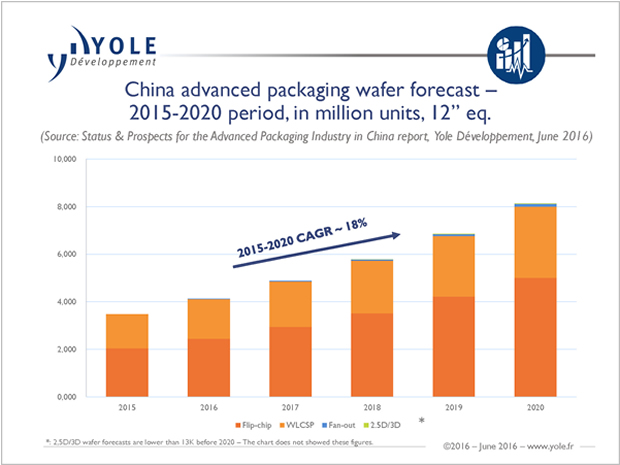What is driving the advanced packaging market in China?
Driven by a strong semiconductor market outlook and aggressive investment in advanced packaging capability fuelled by strong government support, advanced packaging revenue in China is expected to reach $4.6bn in 2020, against $2.2bn in 2015, announces Yole Développement (Yole). This market is showing an impressive 16% CAGR during this period. China has the world’s largest population, and its economy will continue to grow at a high pace: the economists predict a 6% growth, reaching around $16trn by 2020.
Also, an increase in per capita income (more purchasing power) will ensure China remains a dominant market in the coming years. Today, no business can afford to ignore China…
Under this context, the ‘More than Moore’ market research and strategy consulting company, Yole explores the advanced packaging industry in China and details, in its latest advanced packaging report entitled “Status & Prospects for the Advanced Packaging Industry in China”, the status of this industry, its market drivers and key market data and technology trends. Yole’s analysts propose a clear vision of the Chinese government commitment within the advanced packaging industry in China and point out the huge China’s IC investments fund. Business opportunities, technical challenges and more are also part of Yole’s market & technology analysis.
China commands a significant market for key electronic products. In fact, over half of all key electronic products are consumed in China. In 2014, the Chinese smartphone, LCD, notebook/tablet, and wearable markets were around 81%, 63%, 71%, and 47% of the global market, respectively. The global IC market will grow by a CAGR of 4% from 2014-2020, while the Chinese IC market will grow by 7% over the same period. According to Yole, the Chinese IC market is expected to reach about $149bn by 2020, around 40% of the total IC market.
“There is a huge gap between China’s IC consumption and its manufacturing,” comments Santosh Kumar, Senior Technology & Market Analyst at Yole. He added: “In 2015, China produced only 12.5% roughly of the IC it consumes, and the gap between IC consumption and production is about $91bn. Currently, IC is China’s #1 import commodity, exceeding oil.”
China considers the IC industry to be a key strategic sector. The Chinese government is making a significant effort through funding and a national IC policy, with an aggressive growth strategy to make China an IC design and manufacturing hub. The goal by 2030 is to become the global leader in all primary IC industrial supply chain segments.
The Chinese government has employed a multi-pronged strategy to support domestic IC industry development in order to achieve the goal of becoming the global leader in all primary IC industrial supply chain segments by 2030. Over the last few decades the Chinese government has supported the domestic IC industry, but with limited success. One key reason for failure was the bureaucratic approach to resource allocation, which was by nature inefficient. This time around, the government is adopting a market-based approach where funding is available for investment in the form of equity investments rather than subsidies in invested companies. The goal is to generate return on investment while simultaneously aligning with government policy.
Out of more than 200 firms, there are 128 companies having significant advanced packaging & assembly (A&P) operations in China. Yole’s analysts identified around 147 plants all over China, mostly based in Jiangsu (43), Guangdong (30) and Shanghai (22) regions. In this part of the globe, more than 50% of A&P plants belongs to IDMs . A number of Taiwan-HQ OSAT plants are concentrated in Jiangsu, especially in the Suzhou Industry Park. Indeed global OSATs such as Amkor Technology and SPIL are investing in advanced packaging capability of their own Chinese operations: China (Shanghai) operation is the Amkor’s second-largest factory by revenue. The advanced packaging market growth is led by JCET/STATSChipPAC, Huatian, NFME & China WLCSP. And the Chinese advanced packaging market is offering a wide range of platforms including: Flip-chip technology is the largest advanced packaging market segment in China reaching $1.8bn in 2015. The Flip-chip market is covering bumping and assembly steps. “We see a huge ramping of bumping capacity in China, especially by Chinese players with 12” Cu pillar process,” comments Santosh Kumar from Yole. “This growth is mainly supported by the Flip-chip industry in China showing a 16% CAGR between 2015 and 2020”. Flip-chip platform is followed by WLCSP technology with $343m in 2015 as well. Fan-out and 2.5/3D platforms are only emerging in China and will have less than 1% market share by 2020.
Under its latest advanced packaging report, Yole’s advanced packaging team points out the key market drivers of this industry. They list:
- Long-term growth in China IC industry
- Aggressive mergers & acquisitions
- Numerous Chinese government initiatives
- Investments led by global OSATs
- This analysis also gives an overview of China’s semiconductor ecosystem and discusses in detail the country’s advanced packaging market. A detailed description of this analysis is available on i-micronews.com, advanced packaging reports section.








